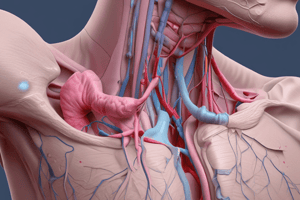Podcast
Questions and Answers
What is the first step in the surgical cricothyrotomy procedure?
What is the first step in the surgical cricothyrotomy procedure?
- Extend the neck (correct)
- Provide traction with the tracheal hook
- Make a horizontal stab incision
- Insert the tracheostomy tube
What is the length of the incision made through the skin, subcutaneous tissue, and cricothyroid membrane?
What is the length of the incision made through the skin, subcutaneous tissue, and cricothyroid membrane?
- 1 cm
- 2.5 cm
- 2 cm
- 1.5 cm (correct)
What tool is used to provide traction in the caudal direction to stabilize the trachea?
What tool is used to provide traction in the caudal direction to stabilize the trachea?
- Forceps
- Hemostat
- Tracheal hook (correct)
- Suction catheter
What is the alternative to a No 4 cuffed tracheostomy tube that can be used in the procedure?
What is the alternative to a No 4 cuffed tracheostomy tube that can be used in the procedure?
During the procedure, which component needs to be palpated to locate the cricothyroid membrane?
During the procedure, which component needs to be palpated to locate the cricothyroid membrane?
Which tool is depicted as option b) in Figure 1 for performing a laryngotomy?
Which tool is depicted as option b) in Figure 1 for performing a laryngotomy?
Which cartilage is located above the cricothyroid membrane in Figure 2?
Which cartilage is located above the cricothyroid membrane in Figure 2?
What is the label of the device shown piercing the cricothyroid membrane in Figures 2 and 3?
What is the label of the device shown piercing the cricothyroid membrane in Figures 2 and 3?
Which anatomical part is shown being pierced by the PCKD in Figure 2?
Which anatomical part is shown being pierced by the PCKD in Figure 2?
What is depicted on the right side of the picture in Figure 3?
What is depicted on the right side of the picture in Figure 3?
Which behavior might indicate impatience?
Which behavior might indicate impatience?
How might someone feel when on the receiving end of aggressive behavior?
How might someone feel when on the receiving end of aggressive behavior?
What kind of reaction involves moving forward physically?
What kind of reaction involves moving forward physically?
Which term describes a lack of willingness to work together?
Which term describes a lack of willingness to work together?
Which behavior is NOT typically a reaction to feeling aggressive?
Which behavior is NOT typically a reaction to feeling aggressive?
Flashcards are hidden until you start studying
Study Notes
Surgical Cricothyrotomy: Rapid Four-Step Technique
- Extend the neck to better expose the trachea to facilitate the procedure.
- Palpate the depression over the cricothyroid membrane with the non-dominant hand to locate the site.
- Make a 1.5-cm single horizontal stab incision through the skin, subcutaneous tissue, and cricothyroid membrane.
- Use a tracheal hook to pick up the cricoid cartilage and provide traction in the caudal direction to stabilize the trachea.
- Place a No 4 cuffed tracheostomy tube or a 6.0 cuffed endotracheal tube through the opening.
People on the Receiving End Feel
- May exhibit aggressive or defensive behavior, such as jabbing movements, banging, clenching fists, or pacing.
- May display resentment or vengefulness.
- May become uncooperative.
Emergency Cricothyroidotomy and its Tools
- Three tools used for performing a laryngotomy: scalpel blade 22, percutaneous key-ring device, and steak knife.
- Correct placement of a device through the cricothyroid membrane is crucial, as shown in Figure 2.
- The cricothyroid membrane is located between the thyroid cartilage and cricoid cartilage, as shown in Figure 2 and Figure 3.
Studying That Suits You
Use AI to generate personalized quizzes and flashcards to suit your learning preferences.




